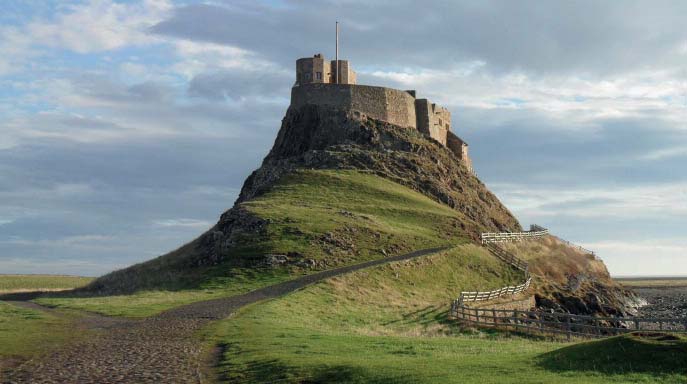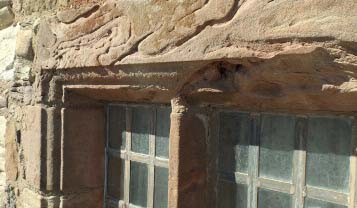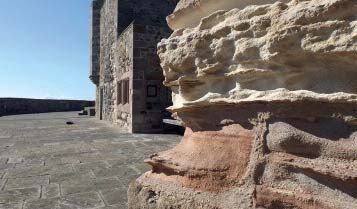Overly hard pointing mixes have caused sandstone blocks around windows to crumble.
Wind and water erosion constantly batters the castle.
Lindisfarne Castle Undergoes Major Repair and Renewal Work
By Nick Lewis, House Steward, Lindisfarne Castle
Like our illustrious counterpart Castle Drogo, Lindisfarne Castle on the Holy Island of Lindisfarne has for many years suffered from water ingress, wind erosion and other kinds of wear and tear routinely endured by historic houses open to the public. Many of these can be monitored on a cyclical basis but, now and again, measures need to be taken to prevent more significant deterioration.
Here at Lindisfarne, we have been planning a major repair and renewal project for the last few years. So far, this has manifested itself in two substantial documents: a Quinquennial Building Survey (QQ) and a Conservation Management Plan (CMP), both of which will be crucial to the coming building works. The QQ — as the name suggests — is a document regularly produced by all National Trust houses to measure and help mitigate the “gradual change” — a conservation term for deterioration — we see in our structures. The CMP, however, is a completely new piece of work.
This document will help us and, most importantly our successors, to use the most appropriate materials and procedures when carrying out works to the castle in the future, be it a simple piece of pointing, a new coat of paint, a major window repair or exterior rendering. In the past, assorted and counter-productive methods and materials have been used in the castle and we hope that, from now on, we can begin to introduce a level of consistency and quality in what we do here. The CMP is designed so that it is adaptable and can be updated in years to come, too, as future generations and technologies come across better solutions than those we have provided.
The first phase of the works will consist of trials around the castle, including window repairs to stop water penetration, external masonry and pointing repairs to allow moisture to enter and exit the structure more easily and internal finish repairs to replace damp plaster and disintegrating paintwork. In each of these areas we will be trying out different methods to see which works best, and giving them about 18 months — including Holy Island’s particularly harsh winter — to produce the best possible results. Once we have obtained these, we will be able to update the CMP with the best new methods and processes to implement throughout the building. What’s more, in March this year, the project received a massive boost when the Department of Culture, Media and Sport gave us a grant of £1.2m to help get this work done. Although we had already begun fundraising for this, this financial aid will now allow us to start the trials immediately and do aspirational works (jobs the Trust would like to do but would never find the money in regular or maintenance budgets to carry out) within the castle’s historic grounds. Now, with this injection of new funds, we will finally be able to restore the stone walls — which can be seen in photographs of the castle in Country Life, taken by its original owner edward Hudson — reopen a section of steps leading to Gertrude Jekyll’s garden and restore an old well shown in photographs from the period just after Lutyens’s renovation of the castle.
Ultimately, this project will last many years and will unfortunately see occasional disruption to visitors. room closures will be necessary at certain stages and some collections will have to be removed from display at times. However, for the long-term wellbeing of the building, such measures are inevitable. Overall, things are moving fairly quickly so, hopefully, we will be able to provide another update in these pages in the near future.





